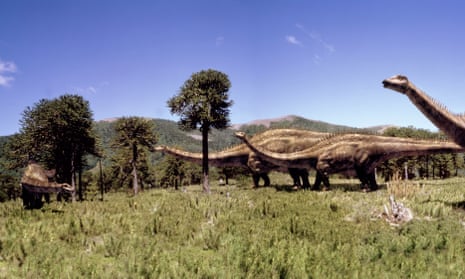Our fascination with giant sauropod dinosaurs such as Diplodocus, Brachiosaurus and Brontosaurus stems from their colossal size. How could something 30 metres long, weighing 50 tonnes, function as a land animal? And how could something that big gain enough nutrition from plants?
We have little evidence for the diet of everyone’s favourite giant herbivores. Reports of fossilised stomach and gut contents have been contested, and coprolites (fossilised dung) are difficult to assign to their producer with any certainty. Indirect evidence from comparative morphology with giraffes and elephants, the largest modern analogues, suggests that sauropods would browse from the tree canopy, although researchers disagree about whether all sauropods held their heads high. Some have even suggested niche partitioning between the different sauropod groups, with the tallest brachiosaurs feeding from the top of the canopy, camerasaurs in the mid-canopy, feeding on seed-ferns and cycads, and diplodocids grazing on ferns and horsetails at ground level.
Indirect evidence from sauropod teeth is perhaps the strongest: many sauropods have well-worn teeth from abrasion by food. Wear patterns on the peg-like teeth of diplodicoids (the group including Diplodocus) have even been analysed to suggest a ‘grab and pull’ mode of feeding, known as unilateral branch stripping. Some titanosaurs (a globally-distributed group of sauropods which survived right up to the end-Cretaceous extinction event) may have had sharp beaks, perfect for cropping coarse vegetation.
The sauropods evolved and became the dominant herbivores before the emergence of the flowering plants (angiosperms) around 130m years ago, so clearly they could gain sufficient nutrients from the flower-free vegetation around them to sustain their enormous bodies. The productivity of an ecosystem – the energy harvested from sunlight and converted into plant biomass – and how efficiently that energy can be used by plant-eaters, dictates the population of plant-eaters it can sustain, so working out the nutritional value of Mesozoic plants to their consumers is a key question for Mesozoic palaeoecology. Which plants provided the best nutrition for a growing dinosaur?
It had originally been theorised that higher levels of carbon dioxide during the Mesozoic, increasing net primary productivity, had driven the rise of the sauropods. However, carbon dioxide levels alone do not dictate primary productivity, and all the other things that a plant needs – light, water and nutrients – would have been limiting factors. Even if primary productivity increased due to elevated carbon dioxide levels, it was thought that the low energy value of non-angiosperms would mean that sauropods would have to consume colossal amounts of plant material. Importantly, carbon dioxide levels also have indirect effects on plant digestibility and nitrogen content.
A new study by Fiona Gill at the University of Leeds, and colleagues at Goettingen and Nottingham, investigated the energy nutritionally available to sauropods from plants grown in Mesozoic levels of atmospheric carbon dioxide, simulated in growth chambers. For canopy plants they used Metasequoia (the Dawn Redwood, a deciduous conifer), Araucaria (the Monkey puzzle, a scale-leaved conifer) and Ginkgo (everyone’s favourite living fossil seed plant). For understorey plants, species of the fern Polypodium and horsetail Equisetum were chosen, along with a buttercup, Ranunculus acris, as an early angiosperm analogue.
The plants were then fermented with cattle rumen fluid for 72 hours to mimic transit through a sauropod gut, and the gases produced analysed to give a measure for digestibility (a technique used in evaluation of agricultural feedstocks). The amount of metabolizable energy from each sample was calculated, and levels of carbon and nitrogen measured.
The study showed that the energy available to sauropods from the fern and Metasequoia were comparable to angiosperms, and that horsetails outperformed angiosperms in terms of their value as a food. This may be related to the low levels of the polymer lignin in horsetails, which use silica as a structural element instead.
Based on these results, Gill and colleagues calculated that a 30 tonne sauropod with a metabolic rate intermediate between modern reptiles and modern mammals would need to eat 110kg per day of Monkey Puzzle foliage grown at 2000 parts per million (ppm) of carbon dioxide (Mid-Triassic levels, five times higher than modern levels), whereas the same animal could get by on only 51kg per day of horsetails grown at only 1200 ppm of carbon dioxide (three times modern levels).
These findings challenge assumptions about both the nutritional quality of non-angiosperm plants such as horsetails, and any generalisations about plant food value at elevated carbon dioxide levels. Different plant species behave differently at higher carbon dioxide levels, and their nutritional values alter in surprising ways – something that our own species could do with considering.
